Table of contents
- Assistance systems For comfort and security
- ABS and cornering ABS
- Wheelie and traction control
- Motorcycles ride well and safely: cornering technique, visual guidance, driving tips
- Engine mappings and chassis
- Driving modes, cornering lights, TPMS
- Blind spot warning, e-call, vehicle networking
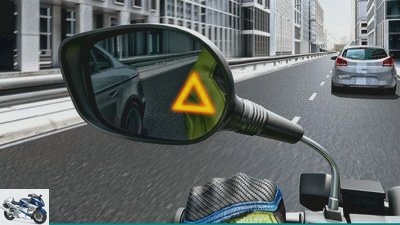
Hirano Ami
counselor
Driving experience & Driving tips
Driver assistance systems for motorcycles
Assistance systems
For comfort and security
Motorcycles ride well and safely
Electronic assistance systems make the performance of modern motorcycles more manageable and offer more comfort, but they can also save us from falling. Current machines have more and more of them, so clarification is needed.
Nicolas Streblow
04/02/2019
In 2018, the Institute for Two-Wheeler Safety carried out a large survey with over 3800 participants on the subject of driver assistance systems. This shows, among other things, that established systems are becoming more popular than recently introduced ones. The best known and meanwhile well received is the ABS. Good thing, because the anti-lock device is by far the most important direct assistance system and has been a requirement for all new motorcycles over 125 cubic centimeters since 2017.
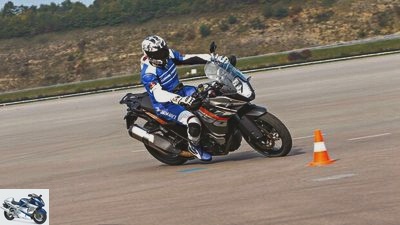
KTM
Cornering ABS helps to keep the lane when braking in an inclined position and only to brake hard enough that the front wheel does not slip.
According to the ifz study, not all motorcyclists know enough about the modern systems, although almost 95 percent of them welcome them. A number of other electronic assistance systems, on the other hand, represent a gain for active safety such as ABS, the meaning and function of which has not yet got around everywhere. A distinction must be made between systems that help, within physical limits, to prevent a slip and those that make driving more pleasant. This is primarily about comfort-oriented electronics. And then there are brand new helpers who even get help after an accident.
In this chapter we have illustrated various situations in which assistance systems for driving dynamics can be useful. Regardless of whether they are called ABS, cornering ABS, anti-slip control, stoppie or wheelie control. What they all have in common is that we do not perceive them as long as we are on this side of the border area. In other words, to be on the road in such a way that it would be possible to do so without all the electronics, even with a conventional motorcycle without all the electronics. They only intervene if we crossed the limit and then fell on our nose without them – or at least had to do everything we could to avoid falling.
ABS and cornering ABS
But what do the individual helpers do? And how do you do it? Let’s start with the well-known ABS, which was first installed in series in 1988. If we apply the brake too hard, i.e. apply too much brake pressure, a valve opens and reduces the brake pressure so much that the wheel no longer locks – in the event of a panic braking, for example.
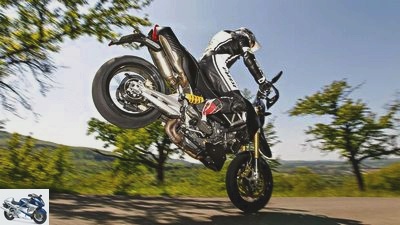
Jorg Kunstle
When braking and accelerating, sensors on both wheels monitor that both wheels are turning and that both remain on the ground. If not, the brake pressure or power will be reduced.
Because it is precisely in this case, where many motorcyclists used to fall, that the technology now enables safe emergency braking. Modern systems work so hard at the optimum that even an experienced driver can no longer gain any advantage without them. Not even on the test track, not to mention everyday life.
This applies in particular to the next level, cornering or lean angle ABS, first presented at the end of 2013 in the KTM 1190 Adventure. In addition to the slippage of the wheels, the computer also includes the inclined position via so-called gyro sensors and, depending on the inclined position, reduces the brake pressure so far that the cornering force is just sufficient. This is an enormous safety gain in the event of a panic braking in an inclined position! However, if the grip is so bad that the bike would have slipped without braking, cornering ABS will of course no longer help.
Wheelie and traction control
The same applies to the now well-known and popular traction control or anti-slip regulation. It represents the opposite of ABS and prevents the wheels from spinning when accelerating. Assuming that you are driving precisely straight ahead, that would not be a safety problem.
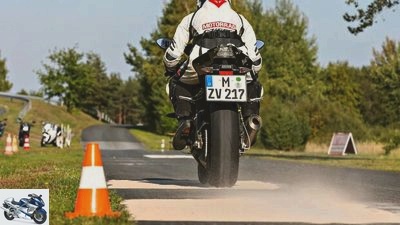
Markus Jahn
The traction control reduces the propulsion when there is insufficient grip and thus prevents the rear wheel from breaking out of the way.
However, if the road is not perfectly level or the motorcycle is tilted, there is a risk of a sideways slide. When the bike is crosswise to the direction of travel and the frightened driver closes the gas, the rear tire gets grip again and the machine throws its tamer in a high arc – commonly known as the “highsider”. The traction control intervenes before it gets that far and, depending on the setting, cuts the power more or less gently. For professionals, the ASR, the anti-slip control, is often adjustable to enable targeted drifts. However, one should always be aware that we have no “slip control” on the front wheel. If we turn too hard and the machine pushes over the front wheel without braking, no anti-slip control will help us, because it controls the rear wheel.
<!– ESI FOR ads.BannerGallery / irelements / esielement / eyJwYWdlIjoiL3N0YXJ0c2VpdGUvIiwibGF5b3V0IjoiYXJ0aWNsZSIsImVsZW1lbnQiOiJhZHMuQmFubmVyR2FsbGVyeSIsImlyQ29uZmlnIjoiMTUyNzk0ODkiLCJwYXJhbXMiOnt9LCJpc01vYmlsZSI6ZmFsc2V9 –> <!– CACHEABLE –>&# 34;,&# 34; rectangle&# 34 ;: “<!–# include virtual = \&# 34 / irelements / esielement / eyJwYWdlIjoiL3N0YXJ0c2VpdGUvIiwibGF5b3V0IjoiYXJ0aWNsZSIsImVsZW1lbnQiOiJhZHMuUmVjdGFuZ2xlR2FsbGVyeSIsImlyQ29uZmlnIjoiMTUyNzk0ODkiLCJwYXJhbXMiOnt9LCJpc01vYmlsZSI6ZmFsc2V9 \&# 34; –> <!– ESI FOR ads.RectangleGallery / irelements / esielement / eyJwYWdlIjoiL3N0YXJ0c2VpdGUvIiwibGF5b3V0IjoiYXJ0aWNsZSIsImVsZW1lbnQiOiJhZHMuUmVjdGFuZ2xlR2FsbGVyeSIsImlyQ29uZmlnIjoiMTUyNzk0ODkiLCJwYXJhbXMiOnt9LCJpc01vYmlsZSI6ZmFsc2V9 –> <!– CACHEABLE –>&# 34;,&# 34; sky&# 34 ;: “<!–# include virtual = \&# 34 / irelements / esielement / eyJwYWdlIjoiL3N0YXJ0c2VpdGUvIiwibGF5b3V0IjoiYXJ0aWNsZSIsImVsZW1lbnQiOiJhZHMuU2t5R2FsbGVyeSIsImlyQ29uZmlnIjoiMTUyNzk0ODkiLCJwYXJhbXMiOnt9LCJpc01vYmlsZSI6ZmFsc2V9 \&# 34; –> <!– ESI FOR ads.SkyGallery / irelements / esielement / eyJwYWdlIjoiL3N0YXJ0c2VpdGUvIiwibGF5b3V0IjoiYXJ0aWNsZSIsImVsZW1lbnQiOiJhZHMuU2t5R2FsbGVyeSIsImlyQ29uZmlnIjoiMTUyNzk0ODkiLCJwYXJhbXMiOnt9LCJpc01vYmlsZSI6ZmFsc2V9 –> <!– CACHEABLE –>&# 34;}}” ga-track-vis =”article.gallery.inline.vis” class =”v-A_-article__inline-container”>
Motorcycles ride well and safely: cornering technique, visual guidance, driving tips
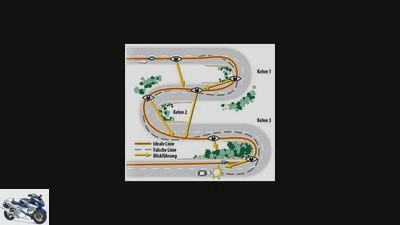
MOTORCYCLE




26th pictures
Images: assistance systems
go to Article
To home page
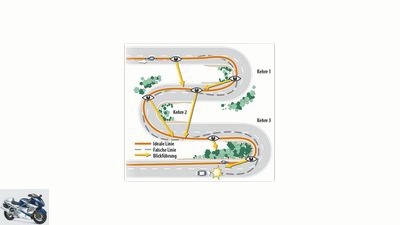
MOTORCYCLE
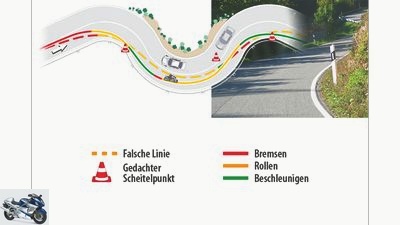
Photo: MOTORCYCLE

Photo: MOTORCYCLE
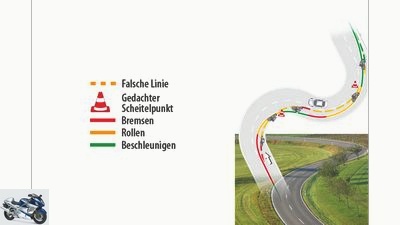
Photo: MOTORCYCLE
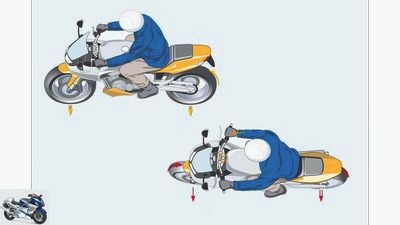
MOTORCYCLE
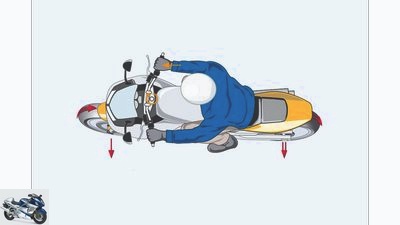
MOTORCYCLE
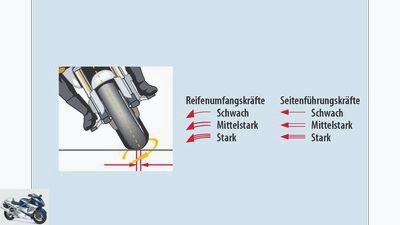
Photo: MOTORCYCLE
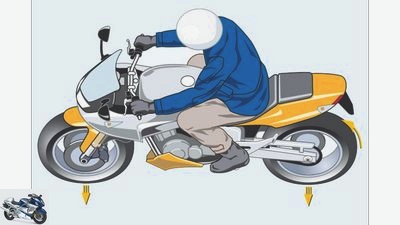
Photo: MOTORCYCLE
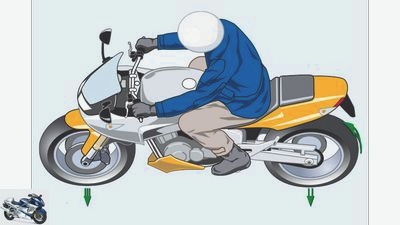
Photo: MOTORCYCLE
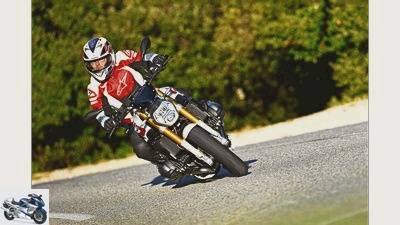
Photo: Gargolov
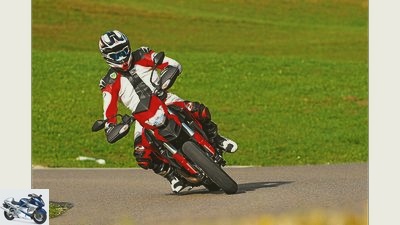
Photo: Bilski
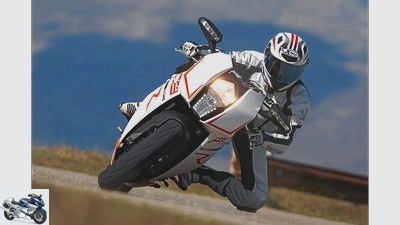
Photo: jkuenstle.de
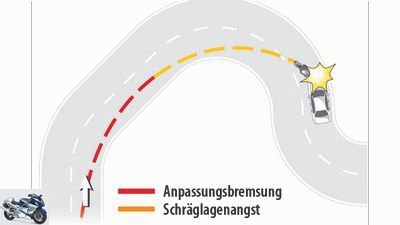
MOTORCYCLE
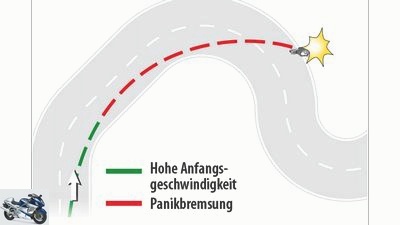
MOTORCYCLE
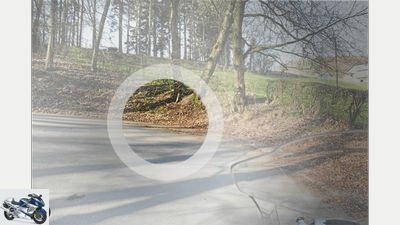
Streblow
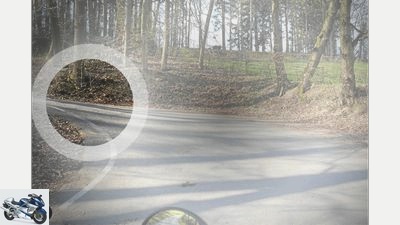
Streblow
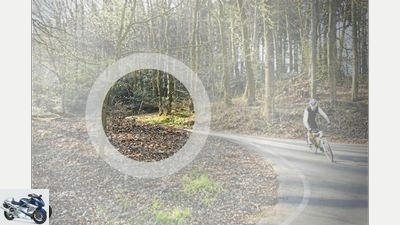
Streblow

Photo: Streblow
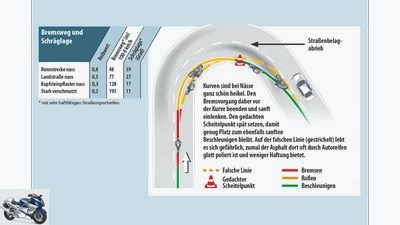
Photo: MOTORCYCLE
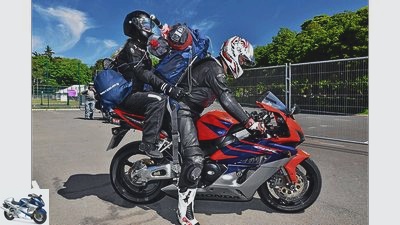
MOTORCYCLE
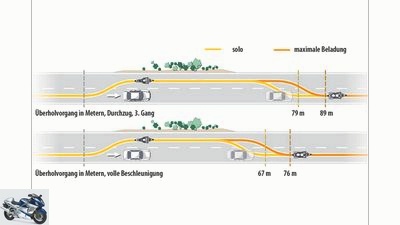
Photo: MOTORCYCLE
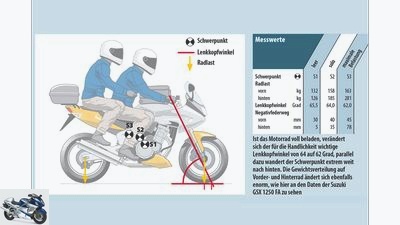
MOTORCYCLE
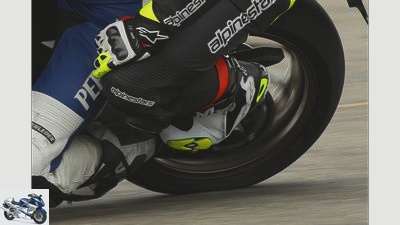
Bilski
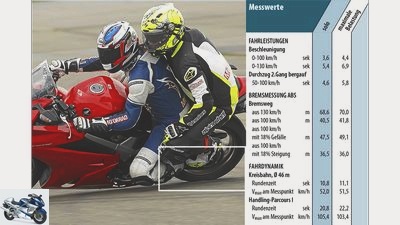
Photo: Bilski
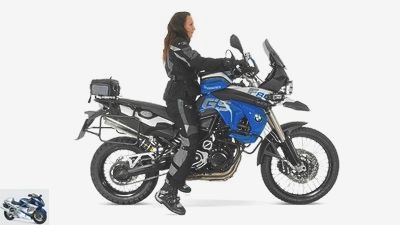
Photo: manufacturer
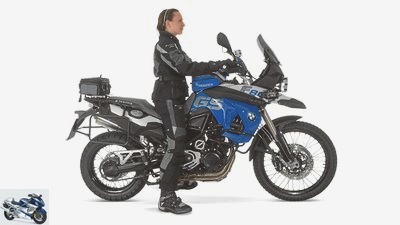
Photo: manufacturer
1/26
The wheelie control also works via the motor control. If the front wheel strives towards the sky when you accelerate, the power is reduced so far that it stays down. In the case of a stoppie, i.e. the rear wheel lifts off while braking, the front brake pressure is reduced to such an extent that the rear wheel just remains on the ground and the driving stability is maintained. The latter device in particular is often referred to as rollover protection. Both techniques are currently used in motorsport in order to be able to brake and accelerate to the limit. During races, as a spectator, you can clearly hear the onset of ASR when accelerating out of the corners by the changed engine noise. It goes without saying that powerful machines are also safer on the road, provided that the physical limits are not exceeded.
Engine mappings and chassis
Adjustable engine mappings, in which the reaction of the injection system to commands from the throttle grip can be adjusted, can also be of great help to driving safety. Crisp and direct for a brisk ride on dry roads, for example, or a little more restrained and more gentle on wet roads.
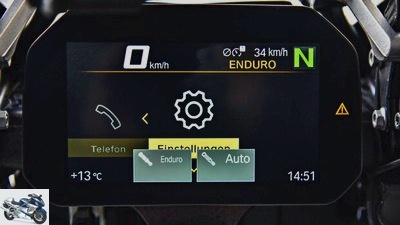
Nicolas Streblow
Motor mappings, ABS and chassis can be programmed using driving modes; here everything is in “Enduro” mode, the suspension on automatic.
Electronics has now also found its way into the chassis of modern bikes, in the form of spring elements that can be adjusted at the push of a button, which can be adapted to different load conditions or changing road conditions. Instead of getting your fingers dirty with a hook wrench, adjusting wheels or even screws, all you have to do is press a button, and the damping and spring preload are appropriately adjusted using electronically controlled servomotors. Since an incorrectly adjusted chassis can also mean a safety risk in addition to limited driving pleasure, the bits and bytes instead of the clicks are more than an extra convenience. Especially when the driver is not deep enough into the subject to pick the right one from the countless possibilities. The idea becomes completely fascinating when an “active” chassis is installed that automatically adjusts the damping and response behavior of the suspension elements to the respective road surface, even while driving, depending on the speed.
Driving modes, cornering lights, TPMS
The crowning glory of many current travel enduros, super sports bikes and large tourers is the combined setting of all the parameters mentioned so far by selecting different riding modes.
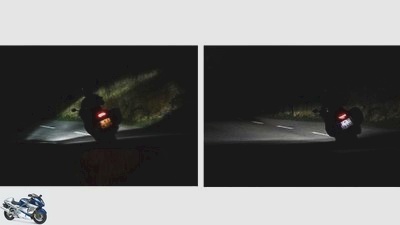
Jorg Kunstle
The cornering light is controlled by inclined position sensors and compensates for the reduced light output of the inclined headlights (left picture), the light cone illuminates the bend better (right picture).
In the “Sport” position, for example, the response to the gas is more direct, full power is available, ABS and ASR regulate late, the damping is tight. With “Rain” the power is reduced, the engine accelerates more gently, the chassis does not act as tightly and ABS and ASR intervene earlier. This can make handling a powerful, heavy motorcycle much easier. With “Enduro”, the damping is opened even further so that the wheels are always in contact with the ground on bumpy terrain, the ASR allows drifts and the ABS reacts late at the front and is even switched off at the rear depending on the model.
Tire pressure monitoring systems, or TPMS for short, warn of insufficient air in the tires. There are different systems, all of which have in common that they measure the tire pressure and issue a warning in the cockpit if it falls below a predetermined value.
Also no driving aids, but the active safety are very useful. In the case of cornering lights, an inclined position sensor, coupled to swiveling reflectors, ensures that the road is well illuminated, even when cornering, where you would otherwise like to push a large, black wedge in front of you.
Blind spot warning, e-call, vehicle networking
The feature shown in the picture above warns of vehicles in the adjacent lane with a glowing triangle that we would only see if we turned our head to the side. In two-wheelers currently only installed by BMW on the large C 650 GT touring scooter, this technology has already found its way into many models in the automotive sector. Hopefully it will always reliably detect motorcycles and scooters in the “blind spot”.
If, despite all caution, an accident does occur, a system such as E-Call can help. Permanently installed on the motorcycle and connected to a control center via a mobile phone emergency call, E-Call calls for help when the sensors detect an accident or fall, even if the driver is no longer able to do so. If he can be contacted, the head office can also contact him. A function that can save lives, especially in single accidents on lonely routes. But even if the biker has an accident, he can take action himself and use the SOS button to reach the emergency call center directly and get help.
In the automotive sector, the networking of road users is already being decisively promoted. Vehicles can communicate with each other via WLAN and cellular radio, for example, and recognize approaching other vehicles before the driver can see them himself. You can either only warn the driver or the technology can even initiate driving maneuvers that avert an impending collision. Many manufacturers are already working on systems that also include motorcycles. It remains to be hoped that fewer motorcyclists will actually be overlooked in the future.
Related articles
-
Active safety systems in motorcycles
Bosch 10 pictures MOTORCYCLE archive 1/10 ABS – Should prevent the wheels from locking when braking hard or on slippery surfaces. KTM 2/10 “Cornering ABS…
-
Electronic driver assistance systems for motorcycles
Yamaha 35 pictures www.factstudio.de 1/35 How things are going? It was a long way from the almost purely mechanical cockpit of the Yamaha SR 500 to the…
-
Additional safety through assistance systems
Security campaign Consideration has right of way Yixin Chen 7th pictures Yixin Chen 1/7 Bosch 2/7 Adaptive Cruise Control adapts the speed to the flow of…
-
Yamaha YZF-R1 driver assistance and chassis
bilski-fotografie.de counselor workshop Yamaha YZF-R1 driver assistance and chassis Assistance systems and chassis of the Yamaha YZF-R1 The perfect match…
-
Ducati 1299 Panigale assistance systems coordinate setup
markus-jahn.com 28 pictures fact 1/28 Ducati Superbikes in a generation comparison. fact 2/28 Bite-proof and easy to dose: anchor of the 1198. ABS was…
-
Kawasaki with radar-based assistance systems from 2021
Motorcycle fair in Milan EICMA 2021 Presented by Kawasaki counselor technology & future Kawasaki with radar-based assistance systems from 2021 Kawasaki…
-
Bosch counselor technology & future eCall systems for motorcycles eCall systems for motorcycles Challenges in accident detection and emergency calls A…
-
Nine 48 hp motorcycles tested for the A2 driver’s license
Jahn 44 pictures Jahn 1/44 Thanks Brussels: With the new tier driving license for young drivers and newcomers, the EU has given a hefty surcharge of 14…
-
4 lean ABS systems in the endurance test
4 lean ABS systems in the endurance test Lean ABS systems put to the test 4 current curve anti-lock braking systems in comparison Full in the irons with…
-
Motorcycles with cornering ABS in comparison
Photo: fact 28 pictures archive 1/28 BMW took on the pioneering role when it came to the spread of ABS in motorcycles. The following models want to show…